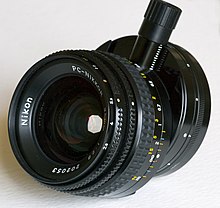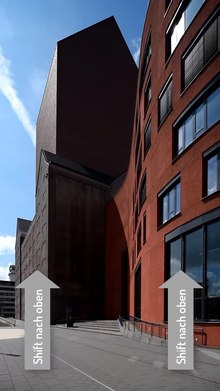Shift (photography)
Shift or shifting , also called parallel shift in German , is a procedure in photography in which the lens can be shifted parallel to the image plane . To shift is derived from English, which means to shift or to move . Shifting the lens allows you to take pictures to the side or up or down without having to pan the camera ( tilt ). The image remains distortion-free (no converging lines ). Shifting plays a major role in architectural photography .
Motivation and functioning
Converging lines occur in photography when the image plane (i.e. the film plane or the image sensor plane) and the subject (more precisely, the subject plane, which should not contain any converging lines) are not aligned parallel to one another. When using cameras or lenses without a shift function, you are forced to use this non-parallel alignment with large-area subjects, either in order to be able to record the subject at all or not to leave a large part of the image unused. With the centered lenses that are usually used, the selection of the image section is only possible by tilting or swiveling the camera, whereby the recorded image can later be rectified with a loss in image quality .
When shifting, on the other hand, one shifts the optics in relation to the film or image sensor position to be aligned parallel to the motif in order to select the image section without changing the projection . The lens does not change the perspective , as this is predetermined by the position of the camera (more precisely, by the position of the entrance pupil of the lens) and the straight-line propagation of the light.
Shifting in the small image area is possible using special shift lenses (or combined tilt-shift lenses), in the large format area by parallel shifting of the standards. In both cases, the lens must have an enlarged image circle, since it no longer uses the center of the image, but also image areas further out.
Remarks :
- Although the terms perspective and projection denote different processes in the creation of images, in practice both terms are mixed, combined or even swapped.
- Shifting cannot correct the perspective due to an unfavorable camera position.
- In the English-speaking world, vertical shift movements are often referred to as rise and fall , while shift usually means lateral movements.
Applications
The orientation of the camera determines the object plane, with shifting you can then determine the center of the image. This can solve various problems:
- Dodging to the side: If an interfering object (e.g. a mast) is in the direct line of sight, the photographer can stand next to the object and correct the projection by shifting so that this shift is not immediately noticeable.
- Change of reflections: If the photographer or an unwanted object is reflected in the subject, the position can be changed by shifting so that a more advantageous reflection results in the subject.
- Panoramas: When taking a picture, you take the subject once shifted in one direction and then shifted in the other direction in order to then combine them into a panorama.
Technical implementation
There are several ways to use the rectifying effect of shifting when processing photographs.
When taking a picture, the lens must have a sufficiently large image circle so that the entire light-sensitive surface (film / sensor) is still fully illuminated even when it is shifted:
- With 35mm cameras, special lenses are usually used ( tilt-and-shift lenses ).
- In the case of large format or view cameras , at least the adjustability of the front standard is common, with which the effect can be achieved.
- With digital, mirrorless system cameras with image sensors that are smaller than the 35mm format, conventional lenses built for 35mm film can be used with appropriate adapters.
In post-production:
- In the case of film negative enlargements, the effect can be created later when an image is exposed onto the paper. To do this, the enlarger requires a shift lens or a correspondingly adjustable lens standard.
- For images that are in electronic form, universal image processing programs or special tools such as ShiftN offer manual or automatic functions with which converging lines can be subsequently corrected.
If rectification is planned during post-processing, a few points should be taken into account when taking the picture so that the results come as close as possible to the performance of a special lens:
- Provide a sufficient edge of the picture, as a trapezoidal picture is created after the rectification, which is usually cropped and thus experiences a loss of edge.
- Sufficient resolution or lower output resolution, since compression and stretching of an image are always associated with a loss of detail and sharpness.
Demarcation
In some cameras and video cameras, the sensor or part of the optics is moved to stabilize the image . In principle, the procedure and the effect correspond to shifting, but the shifts are relatively small.
Web links
credentials
- ↑ http://foto-net.de/net/kameras/gross.html
- ↑ Shift lenses ( page no longer available , search in web archives ) Info: The link was automatically marked as defective. Please check the link according to the instructions and then remove this notice. , Discount Objectiv, accessed online April 12, 2013



